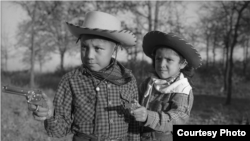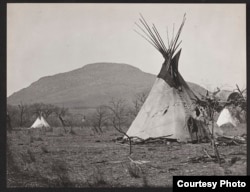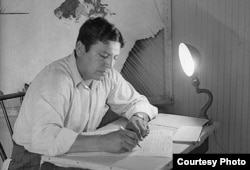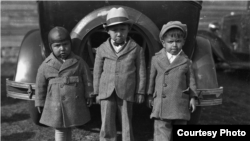One afternoon when she was about seven years old, Linda Poolaw and her older brother, Robert, stepped off of the school bus to find their father, Kiowa Indian photographer Horace Poolaw, waiting in ambush, his camera in hand.
“He put cowboy hats on our heads and gave us pistols to hold,” Linda remembers. Whether the photo was meant to be ironic or not, Linda isn’t sure. All she knows is that she never much cared for it.
“No, it’s not because of the ‘cowboyness’ of it or the whiteness or racism or anything like that,” she said. “It’s just that Dad made us pose for him all the time. We had to be still. We had to wait for him to get the shot just right when all we wanted to do was go play.”
That photo is among a collection of more than 80 currently on display at the National Museum of the American Indian in Washington in an exhibit entitled “For a Love of His People: The Photography of Horace Poolaw.” The collection documents the gradual – if enforced -- assimilation into Western concepts of modernity and challenges, say critics, conventional views of Native Americans as “others.”
From tipi to mainstream
Horace Monroe Poolaw was born in 1906 in Mountain View, Oklahoma, a small town that grew up around the railroad.
Up until the late 19th Century, Oklahoma’s Indian Territory belonged to the tribes that lived or had been relocated there. In the 1860s, the Kiowa, Comanche and Apache were consigned to a nearly three-million-acre reservation. But 20 years later, a law known as the Dawes Act allowed Congress to divide communal land into plots of up to 160 acres in size, which they assigned to individual Indians. The rest was opened up to non-Native settlers.
Horace’s father, Kiowa George, was the son of a distinguished warrior and is said to have kept a tribal calendar, a record of historic events that Kiowa traditionally painted onto buffalo hide or in ledgers. Horace’s mother was descended from a Mexican woman who had been captured during a Kiowa raid.
“It was a way to make up for a shortage of women,” Linda said. The truth is a little more complex than that. A diminishing buffalo population and outbreaks of smallpox and cholera among the tribes led the Kiowa and their allies to conduct a series of devastating raids on Texas and Mexico for horses and human captives.
At first, the Poolaw family lived in a traditional tipi, but they eventually moved into frame house that remains in the family today.
The recently-built Rock Island railroad line brought an influx of settlers from the east, including itinerant photographer George W. Long, who set up shop in Mountain View. He served as a mentor to Poolaw and gave the youth his first camera.
Poolaw would spend the next 50 years of his life documenting the daily lives of family, friends and fellow Kiowa at work and play, as they made the transition, says his daughter, “from tipi to mainstream.”
“He developed his own pictures, even though there was no electricity or water in the house back in those days,” said Linda. “He had to send to Chicago for film and developing supplies.”
The high cost of paper and film meant Poolaw worked hard to get his shots right on the first try, and he only developed a fraction of the photos he took. He took all of his photographs outdoors because it eliminated the need for flashbulbs.
Horace would occasionally print photo postcards on large sheets of paper, which his children would trim and peddle at the bus station for five cents apiece as a way to make money.
“We were poor, dirt poor,” said Linda. “But we didn’t know it because everybody around us was poor too.”
Today, those postcards sell for as much as $50 on internet auction sites.
Poolaw married twice; Linda is the daughter of his second wife, Winnie Chisholm (Delaware/Seminole/ Creek). He wore many hats in his life, he was a farmer and raised cattle. For a time, he worked for the Oklahoma Highway Patrol. Then, in 1943, he enlisted in the Army, where he was trained in aerial photography. At the end of World War II, he moved to Anadarko, where Linda was born.
Poolaw continued taking pictures until the 1970s, when his eyesight began to fail. In 1979, the Southern Plains Indian Museum in Anadarko organized a retrospective exhibit of his photographs. It would be the only showing of his work during his lifetime.
When he died in 1984, he left behind 2,000 negatives. In the late 1980s, his daughter collaborated with Stanford University to develop and catalogue his photos. The resulting exhibit and accompanying catalogue, “War Bonnets, Tin Lizzies and Patent Leather Pumps: Kiowa Culture in Transition 1925-1955” toured the United States and was the subject of a documentary film.
Challenging stereotypes
Today, art historians and critics view Poolaw’s work as equal to many better-known photographers working in the Western frontier in the early 20th Century. His photographs are most often described as documenting the transition from 19th Century traditional ways of life into mainstream Americana.
But Laura E. Smith, art historian and author of a book on Poolaw, sees him through a different lens.
“One of the things that I would like to refute is this idea of transformation between traditional and modern, as if something historic had died and as they modernized, they became less authentic as Indians,” she said. “Indigenous people survived and they continue to live and thrive. Sure, not everything is the same, but neither is any culture the same as it was in the 19th century.”
His work documents the tribal community as it really lived and evolved, said Smith, as both Native Americans and American citizens, simultaneously assimilating and resisting.
“If we situate his work within the legacy of Kiowa art, then Poolaw maintained ancestral practices of visually documenting Kiowa history,” she said. “If we situate his work within documentary photography, then Poolaw puts a face on the 20th Century Kiowa experience.
And if viewers regard his work simply as portraiture, then, says Smith, Poolaw gives “thoughtful, loving, sometimes comedic and ironic representations of his modern community.”




